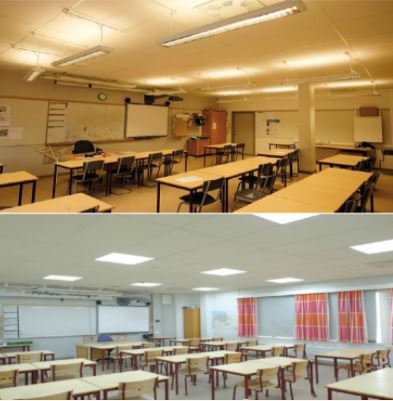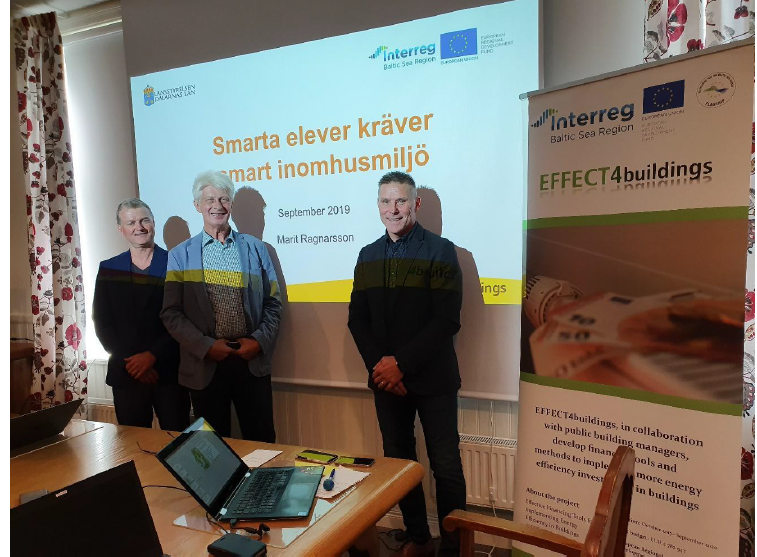Today, people are spending more and more time indoors. In the urbanised western world, we spend around 90% of our time in an enclosed space. Studies show that time spent in the home is increasing and can represent up to 19 to 20 hours per day for children and the elderly (1). Thus the importance of being comfortable during these hours is increasing. Research reveals that there is a clear link between indoor climate and health.
The four main factors that affect people’s perception of indoor comfort are:
– thermal comfort (air temperature, humidity, draughts, etc.)
– visual comfort (view, luminosity, glare, etc.)
– acoustic comfort (noise from outdoors, vibrations, intelligibility of speech, etc.)
– air quality (fresh air supply, pollutants, odours, etc.)
During four seminars in Dalarna during September 2019, our project EFFECT4buildings asked the following two questions:
– How can we build smart and have both energy efficiency, health and well-being in mind?
– How can we increase innovation and re-thinking among real estate companies and politicians when procurement is prepared for rebuilding and new constructions?
Energy and good indoor climate are closely related. By counting on more added values that you can get through an investment, the motivation to make the investment increases. For example, demand controlled ventilation saves energy and more daylight reduces need for lighting.
To raise awareness and knowledge among our target group politicians, business executives and property managers, we decided to organise four half-day seminars in three municipalities during September 2019. Two in Falun, one in Borlänge and one in Gagnef.
We invited three experts on Air quality and thermal comfort, Visual comfort and Acoustics.
Air quality and thermal comfort – Stefan Lysén
Stefan Lysén raised 5 factors for a good air quality. All parameters are important since they affect each other and individual actions can have a negative impact on others. The key factors are temperature, humidity, CO2, particles and foreign substances.
The level of humidity is important. When the humidity is between 40% and 60%, the risk of unwanted microorganisms and symptoms is lower. Recent studies also confirm that the transmission of viruses, e.g. cough, decreases significantly at a humidity above 45%.
During spring and summer this year, Stefan conducted surveys in four schools that was presented during the seminar. Some of the findings in summary:
– Too hot in the classrooms
– Dry air due to excessive ventilation and / or particles
– Too much particles and dust in shelves, furniture
– Not enough light in classrooms, many old installations
– High sound from ventilation in many classrooms
– High radiation temperature in fluorescent lamps
– Low awareness among personell of the status of the buildings
– Also measure wintertime is important
 Photo: Seminar in Falun, Stefan Lysén speaks about air quality
Photo: Seminar in Falun, Stefan Lysén speaks about air quality
Visual comfort – Reine Karlsson
Reine Karlsson explained that the quality of the lighting affects health and well-being much more than most people are aware of and that there is a big difference in customer value and society value between different LED lamps and between different light environments. Premises that appear to be not so esthetic and not so attractive have low customer value. Schools with inappropriate lighting have lower society value.
The quality of indoor lighting is important because indoor lighting is important for people’s health and well-being. Investing in LED lighting that provides good and appreciated lighting environments is a cost-effective way to show that a school cares about its students and teachers.
The spectral distribution and the proportion of directed light are also important to be able to interpret people’s facial expressions.
The quality of light is important for our visual function, how we see things and our emotional experience, interpretation of facial expressions, security, well-being and stimulation. For example is intense bluish light good in the morning, but not in afternoons and evenings.

For more information: http://lightingforpeople.eu/malmo-school-introduces-human-centric-lighting/
Acoustic comfort – Jonas Christensson
It’s important that classrooms provide good conditions for both listeners and speakers. To listen without effort is important for learning, and we know that a poor sound environment is a burden that impedes learning and have a negative effect on teachers voice health.
The sound reflections have a great impact on both the speaker and the listeners. In most languages the information is carried out by the consonants, looking at the speech spectra we see that most vowels are low in frequency and high in strengths and most consonants are low in strength and higher in frequency. If the room reflections amplify the lower frequencies the “strong” vowels will be “stronger” and have a masking effect on the consonants. These rooms have low speech intelligibility. To create good speech intelligibility it is important that the surfaces in the room amplify the higher frequencies.
A place that amplifies the higher frequencies is the Swedish forests. Jonas have done several listening and speaking tests in different forests. Most people feel that it’s very easy to understand what the speaker says, good speech intelligibility, and it’s also very pleasant to speak in a forest, good speak comfort. The results are interesting and he means that “forest acoustics” should be the goal in terms of acoustic conditions in classrooms.
How to order a good sound environment? Jonas explained that the Housing Agency places demands on the sound environment in buildings. The requirements are obtained from SS 25268.
SS 25268 is a Swedish sound rating standard for classrooms, care rooms, offices and hotels.
For more information see www.ljudskolan.se/ljudfakta/

Photo: Seminar in Gagnef
More information about the seminars contact: Hans Ahlin +46739-416265
About EFFECT4buildings: EFFECT4buildings is implemented with the support from the Interreg Baltic Sea Region Program 2014-2020 (European Regional Development Fund) and Norwegian national funding. The aim of the project is to improve the capacity of public building managers in the Baltic Sea Region by providing a comprehensive decision-making support toolbox with a set of financial instruments to unlock the investments and lower the risks of implementing energy efficiency measures in buildings owned by public stakeholders. For more information: http://www.effect4buildings.se
Text author: Hans Ahlin, EFFECT4buildings, Länsstyrelsen Dalarnas län
(1) Source: Bluyssen, P.M. The Indoor Environment Handbook How to Make Buildings Healthy and Comfortable. London, Earthscan, 2009, 95













